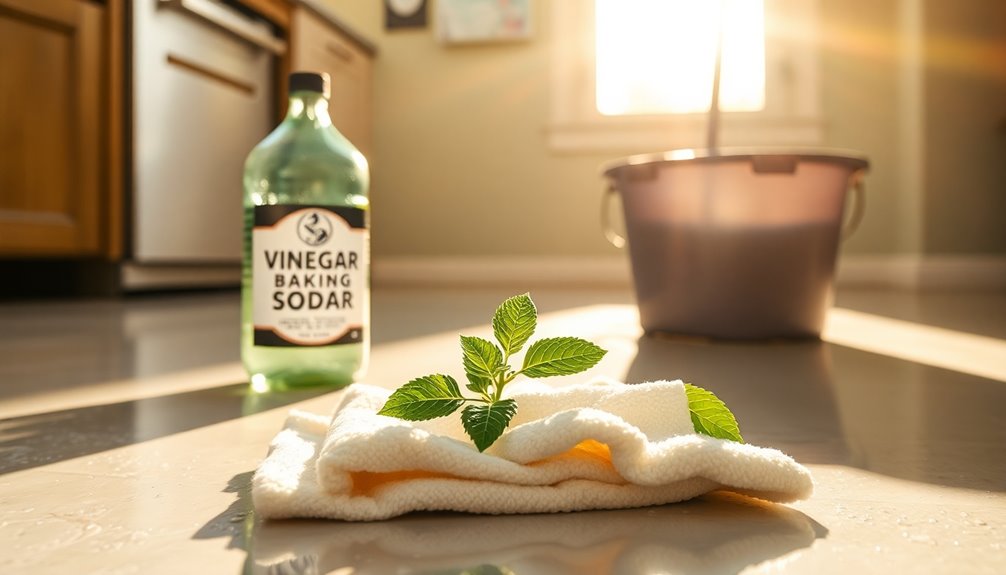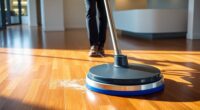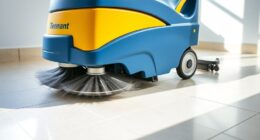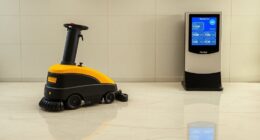You won't believe how simple tricks can transform your floor cleaning routine! Start by choosing the right broom for each area—angle for corners and softer for open spaces. Use electrostatic cloths to catch fine dust. When mopping, try a figure-eight motion and change the water frequently. For tough stains, a paste of baking soda and vinegar works wonders. These clever hacks can really boost your cleaning efficiency, and there's so much more to discover!
Key Takeaways
- Use baking soda and vinegar as a powerful natural cleaner to tackle tough stains and grime on floors.
- Employ a dry mop before mopping to capture dust and debris effectively, ensuring a cleaner surface.
- Try an angle broom for corners and tight spaces, maximizing cleaning efficiency with minimal effort.
- Utilize essential oils in homemade cleaners for added scent and disinfecting properties without harsh chemicals.
- Regularly change mop water to avoid spreading dirt around and achieve a truly clean floor finish.
Effective Sweeping Techniques for a Dust-Free Floor
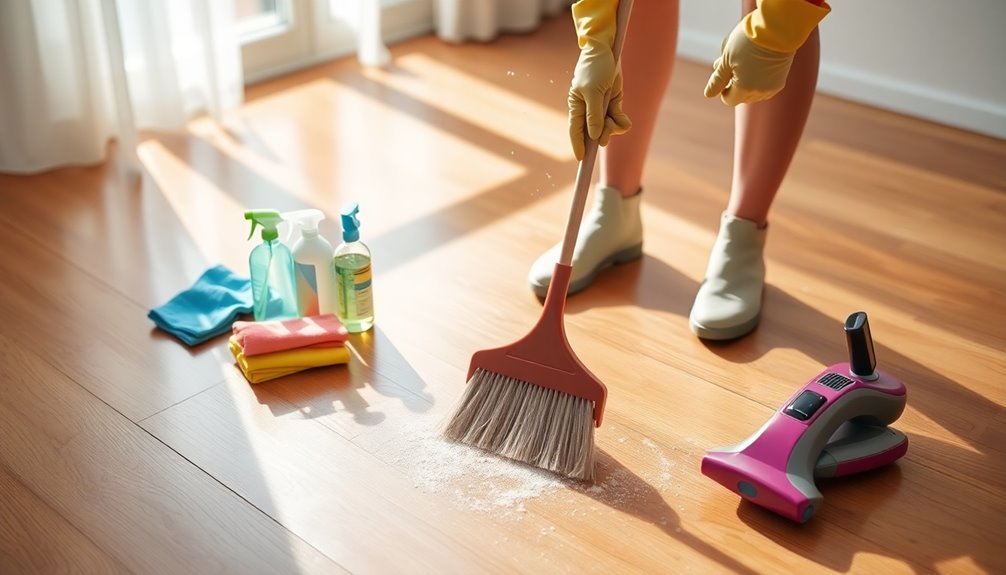
When you want to achieve a dust-free floor, effective sweeping techniques are essential.
Start by choosing the right broom—angle brooms work wonders in tight corners, while softer brooms are best for open spaces. If you're tackling finer particles, consider using electrostatic cloths attached to your broom. Regular cleaning is essential for individuals with asthma or allergies who may be sensitive to dust.
Divide your area into sections for thorough coverage, beginning from the edges and moving toward the center. Use short, deliberate strokes to prevent dust from scattering.
Remember to clear obstacles before you start and keep your dustpan handy for efficient collection. Regular sweeping is key to preventing dust buildup, so make it a habit.
With these techniques, you'll maintain a cleaner, dust-free environment effortlessly!
Mastering the Art of Mopping
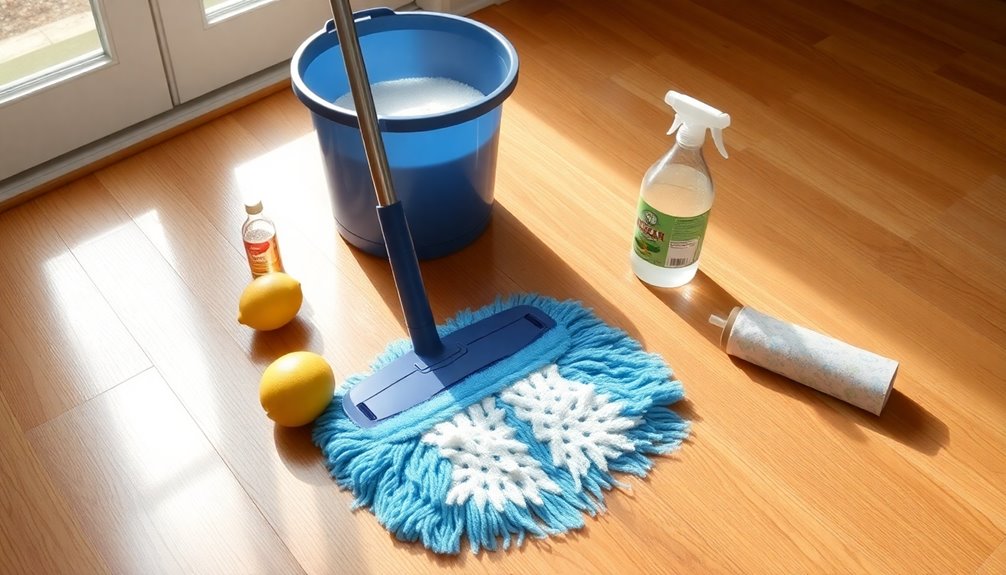
After sweeping away dust and debris, it's time to tackle the next step in floor maintenance: mopping.
Start by selecting the right mop for your flooring type and size. Microfiber mops are great for trapping dirt, while cotton mops excel in larger spaces. Choosing the right mop can enhance overall mopping effectiveness.
Before you mop, clear the area of any obstacles and perform a dry mop to catch lingering dust. Use a figure-eight motion for effective cleaning, dividing large areas into sections to avoid fatigue.
Remember to change your mop water regularly to prevent re-contaminating surfaces. Finally, dry the floor with a clean mop or towel to avoid slips.
Eco-Friendly Cleaning Solutions You Can Make at Home

Creating your own eco-friendly cleaning solutions not only helps the environment but also saves you money. Start with basic ingredients like baking soda, distilled white vinegar, and lemon juice. For a simple cleaner, mix equal parts vinegar and water. If you're tackling tougher stains, combine 5-6 drops of dish soap with ½ cup of vinegar and warm water for a powerful mop solution. You can also use castile soap as a plant-based alternative. To enhance the scent and disinfecting power, add a few drops of essential oils. Vinegar and baking soda are effective for various cleaning tasks due to their bubbling action. Regular cleaning with these ingredients can help maintain your floors and prevent the buildup of grime, which is essential for long-term maintenance. Remember to use reusable cloths to cut down on waste and always spot test new cleaners. With these homemade solutions, you'll keep your floors clean and eco-friendly!
Advanced Tips for Grout and Stain Removal
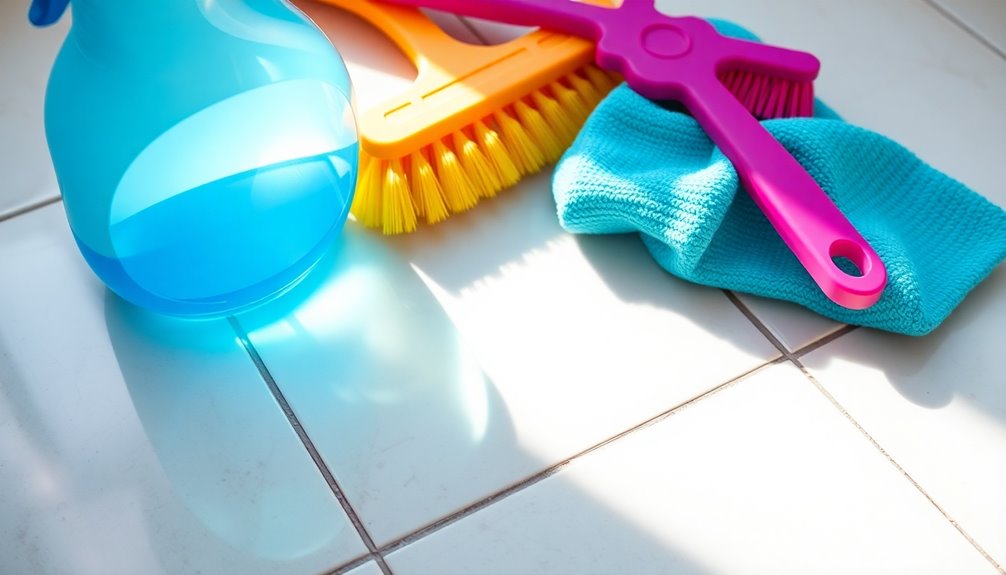
Maintaining clean grout and tackling stubborn stains can be just as important as using eco-friendly cleaning solutions. For advanced grout removal, consider using rotary tools with carbide bits or oscillating multi-tools, as they speed up the process significantly. Understanding different types of grout is crucial for effective removal and helps in choosing the right tools for the job. Additionally, soil moisture check is essential when caring for houseplants, as it prevents overwatering that can lead to mold growth in grout lines.
If you prefer a manual approach, grout saws are basic but can be labor-intensive. Always wear protective eyewear to prevent injuries.
For stains, The Pink Stuff and a baking soda paste work wonders without harsh chemicals. If you're dealing with epoxy grout, use specialized cleaners to avoid damage.
Regular sealing helps prevent future stains, while routine cleaning keeps your grout looking fresh. Choose the right tools based on the grout type for optimal results.
Maintaining the Shine and Longevity of Your Floors

To keep your floors looking their best, regular maintenance is key. Start by stripping old finishes to prepare for new coats, ensuring deep cleaning. Scrub and clean periodically to eliminate scuff marks and dirt, which extends your floor's life. Regular maintenance prevents costly refinishing and extends floor life before complete stripping is necessary.
Buffing and polishing should be done daily or weekly to restore that luster, while burnishing gives a glossy finish when needed. For specific floor types, use appropriate cleaning techniques: dry mop hardwood daily, mop tiles with pH-neutral detergent, damp mop vinyl weekly, and avoid excessive moisture on laminate.
Employ entrance mats to reduce dirt, and use furniture pads to prevent scratches. Lastly, choose floor-specific cleaners and inspect regularly to catch issues early, maintaining your floors' shine and longevity.
Frequently Asked Questions
What Is the Best Way to Store Cleaning Tools?
The best way to store cleaning tools is by utilizing shelves and clear bins for easy visibility.
Hang mops and brooms on doors to save space, and consider using utility carts for quick access to supplies.
Organize your tools by type or task, and maintain a color-coded system for cloths.
Regularly check your inventory and clean storage areas to keep everything hygienic and accessible, ensuring you're always ready for your next cleaning session.
How Often Should I Replace My Cleaning Supplies?
You should replace your cleaning supplies regularly to maintain hygiene and efficiency.
Dish sponges should be swapped every one to two weeks, while dish brushes last about three to four months.
Mopheads need replacing every three to six months, and toilet brushes should go every six to twelve months.
Microfiber cloths can be washed but must be replaced when frayed.
Regular maintenance prevents bacterial buildup and keeps your cleaning routine effective.
Can I Use the Same Mop for Different Floor Types?
Yes, you can use the same mop for different floor types, but it depends on the mop you choose.
Microfiber mops are versatile and work on all surfaces, including hardwood and tile.
Steam mops are great for sealed floors but avoid unsealed wood.
If you're using a sponge mop, it's gentle enough for delicate surfaces.
Always check compatibility to ensure you're maintaining the integrity of your floors while cleaning effectively.
What Should I Do if My Floor Smells After Cleaning?
If your floor smells after cleaning, start by checking your mop.
Make sure it's clean and dry before use, as dirty mop heads can transfer odors. Use filtered water for mopping to avoid mineral buildup.
Also, try minimizing water usage to prevent excess moisture. If the smell persists, consider sealing grout lines or replacing damaged tiles.
Finally, enhance ventilation in the area to help reduce lingering odors and improve air quality.
Are There Any Quick Fixes for Scratches on Hardwood Floors?
If you've got scratches on your hardwood floors, there are some quick fixes you can try.
Rubbing a walnut over light scratches can help conceal them. You can also use wood markers or crayons that match your floor color.
For deeper scratches, consider filling them with wood filler and staining to match.
Additionally, a vinegar and olive oil mixture can minimize minor scratches, making your floors look better without much effort.
Conclusion
Now that you've discovered these incredible floor cleaning hacks, why not give them a try? You'll be amazed at how effective simple techniques and homemade solutions can be in transforming your space. Remember, a little effort goes a long way in maintaining the beauty and longevity of your floors. So, roll up your sleeves, grab those tools, and enjoy the satisfaction of a spotless home. Your floors deserve the best, don't they?
